
The Texarkana and Fort Smith Railway was the Texas subsidiary of the Kansas City Southern Railway, operating railroad lines in the states of Arkansas and Texas, with headquarters at Texarkana, Texas.

Santa Fe Depot, also known as the Santa Fe Transit Hub, is an Amtrak station located in downtown Oklahoma City, Oklahoma. It is the northern terminus of the Heartland Flyer, a daily train to Fort Worth, Texas.

The San Bernardino Santa Fe Depot is a Mission Revival Style passenger rail terminal in San Bernardino, California, United States. It has been the primary station for the city, serving Amtrak today, and the Santa Fe and Union Pacific Railroads in the past. Until the mid-20th century, the Southern Pacific Railroad had a station 3/4 of a mile away. It currently serves one Amtrak and two Metrolink lines. The depot is a historical landmark listed on the National Register of Historic Places as Atchison, Topeka and Santa Fe Railway Passenger and Freight Depot.

Texarkana Union Station is a historic train station in the Texarkana metropolitan area serving Amtrak, the United States' national passenger rail system. The Arkansas-Texas border bisects the structure; the eastern part, including the waiting room and ticket office, are in Texarkana, Arkansas, but the western part is in Texarkana, Texas, meaning stopped trains span both states. The station was built in 1928 and was added to the U.S. National Register of Historic Places in 1978. Today it is the second busiest Amtrak station in Arkansas.
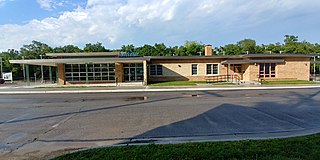
Lawrence station is a train station in Lawrence, Kansas, United States, served by Amtrak's Southwest Chief train. Built in 1956 to replace an older station, it was added to the National Register of Historic Places in 2018 as Santa Fe Depot.

Baton Rouge station is a historic train station located at 100 South River Road in downtown Baton Rouge, Louisiana. It was built for the Yazoo and Mississippi Valley Railroad which got absorbed by the Illinois Central Railroad. The station was a stop on the Y&MV main line between Memphis, Tennessee and New Orleans, Louisiana. The building now houses the Louisiana Art and Science Museum.
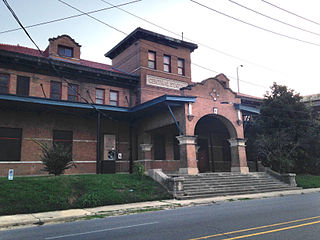
Shreveport Central Station is a historic train station in Shreveport, Louisiana. It was built in 1910 by the Louisiana and Arkansas Railroad, a railroad that was eventually acquired by the Kansas City Southern Railway. By the opening of the 1940s the L&A and the St. Louis Southwestern Railway or 'Cotton Belt' moved its passenger operations from Central Station to Shreveport Union Station.

The Frisco Depot in Fayetteville, Arkansas, is a railroad depot built in 1925. The last passenger trains left Frisco Depot in 1965, and starting in 2011, the depot's interior houses a Chipotle Mexican Grill. The property was listed on the National Register of Historic Places on December 8, 1988.

Hope station is a passenger rail station in Hope, Arkansas. The station is located on Amtrak's Texas Eagle line. Trains run daily between Chicago, Illinois, and San Antonio, Texas, and continue to Los Angeles, California, 2,728 miles (4,390 km) total, three days a week.

U.S. Highway 71 is a U.S. highway that runs from Krotz Springs, LA to the Fort Frances–International Falls International Bridge at the Canadian border. In Arkansas, the highway runs from the Louisiana state line near Doddridge to the Missouri state line near Bella Vista. In Texarkana, the highway runs along State Line Avenue with US 59 and partially runs in Texas. Other areas served by the highway include Fort Smith and Northwest Arkansas.

The Glenwood Iron Mountain Railroad Depot is a historic train station building in Glenwood, Arkansas. It is a single-story wood-frame structure, located just west of the point were U.S. Route 70 crosses the Union Pacific tracks. It was built c. 1910 by the St. Louis, Iron Mountain and Southern Railway, and used by that railroad and its successor, the Missouri Pacific Railroad until 1969. It was sold that year and relocated out of town for use as a hay barn. The city purchased the building in 1995, and returned it to a location a short way south of its original location, which is now occupied by a major road intersection.
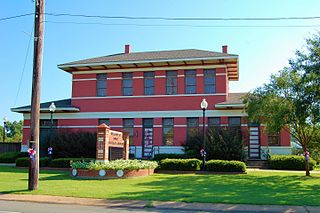
Bunkie station is an historic train station in Bunkie, Louisiana.

The Kansas City Southern Railway Locomotive No. 73D and Caboose No. 385 are historic railroad equipment located near Arkansas Highway 59 and Church Street in Decatur, Arkansas. The locomotive is an EMD F7A built in 1950, and used in service by the Kansas City Southern Railway until 1991, although it was converted to a slug unit sometime in the 1970s and the body was filled with concrete and old wheels. The caboose was built in 1952 by the Louisiana and Arkansas Railroad, a division of Kansas City Southern, and used in service until 1991. Both were purchased in 1991 by Peterson Farms, restored, and placed on display near the former Kansas City Southern depot in Decatur.

The Kansas City Southern Railway Caboose No. 383 is a historic railroad caboose in Centennial Park near Arkansas Highways 59 and 72 in Gravette, Arkansas. It was built in 1952 by the Louisiana and Arkansas Railroad, a division of the Kansas City Southern Railway, and served the latter until 1990. It was given to the city of Gravette in 1991, which had the vehicle restored and placed in the park. The caboose illustrates advances in caboose design, because it was built with bay windows rather than a cupola for observing the train, a change necessitated by increasing large loads being carried.
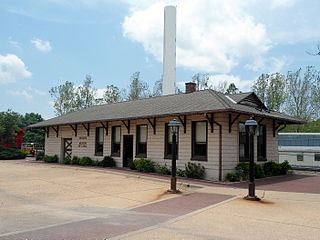
The Kansas City-Southern Depot is a historic railroad station at Arkansas Highway 59 and West North Street in Decatur, Arkansas. It is a long rectangular single-story structure, built out of concrete blocks. It has a hip roof with Craftsman-style brackets and two fisheye dormers, and a cross-gable projecting telegrapher's bay decorated with fish-scale wood shingles. It was built c. 1920 by the Kansas City Southern Railway.

The Mena Commercial Historic District encompasses the historic downtown area of Mena, Arkansas, the county seat of Polk County in western Arkansas. The district extends along Mena Street between Port Arthur and Gillham Avenues, extending a short way to the south on Sherwood Avenue, opposite the railroad tracks for which the town's existence is responsible. Mena was founded as a major railroad service town for the Kansas City, Pittsburg and Gulf Railroad, as its site was located midway between Port Arthur, Texas and Kansas City, Missouri. The railroad located a major service yard here, and the town grew up around it. Most of its commercial center was developed between 1896 and 1940, with a variety of one and two-story commercial brick buildings in typical early 20th-century styles. The district, listed on the National Register of Historic Places in 2009, includes four properties previously listed separately: the railroad station, Mena City Hall, the former Elks Lodge, and the former Studebaker Showroom.

The Kansas City Southern Depot is a former Kansas City Southern Railway station located at the intersection of Spanish and Port Arthur Streets in Zwolle, Louisiana. Built in 1914, the depot is the only surviving building connected to the railroad in Zwolle. The railroad was built through the Zwolle area in 1896, and the town was founded shortly thereafter; the 1914 depot was a replacement for the town's original station. The railway station was an important shipping center for the town's lumber industry; lumber was Sabine Parish's chief export from the early 1900s through the 1940s, and the railroad made Zwolle one of the two main milling towns in the parish.
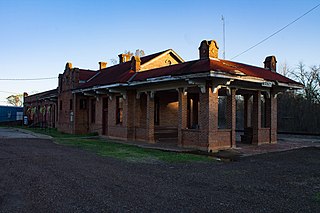
The Kansas City Southern Railway Depot is a historic former Kansas City Southern Railway station located at 750 West Georgia Avenue in Many, Louisiana. The depot was built in 1929 to replace the original depot, which opened in 1896 when the railroad was completed through the town. The Spanish Colonial Revival building features arched parapets atop projecting walls and corner piers with curved decorative pieces on top. Many's economy and municipal government were revitalized by the railway's completion, and the station brought both passengers and freight to and from the town. The local lumber industry, the chief export of Sabine Parish, shipped its products out through the station, and a small business district grew around the station.
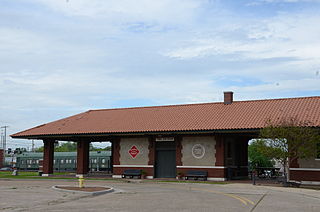
The Russellville, Arkansas Missouri Pacific Depot is a historic passenger railroad station located just north of the intersection of South Denver Avenue and West C Street. It is a long rectangular single-story masonry building, finished in brick and stucco and covered by a hip roof with supporting Italianate brackets, designed in a Mediterranean style that was popular when it was built. At both ends, the roof extends beyond the structure to form a sheltered porch supported by square brick columns. A telegrapher's booth projects from the building's north (track-facing) side. An open breezeway separates the passenger and express freight sections of the depot. Three brick chimneys rise through the ridge line, two above the passenger section to the east and one above the freight section to the west. Completed in February 1917, it is typical of many railroad depots of that period; its original tile roof has been replaced by composition shingles.
E. M. Tucker was an American architect of St. Louis, Missouri, who worked for the Missouri Pacific Railroad.





















